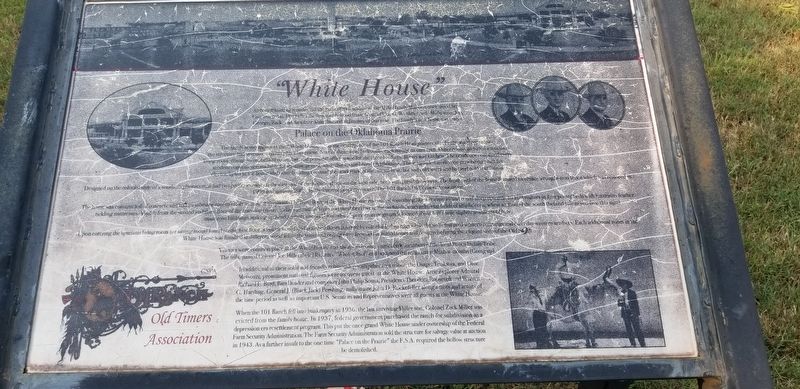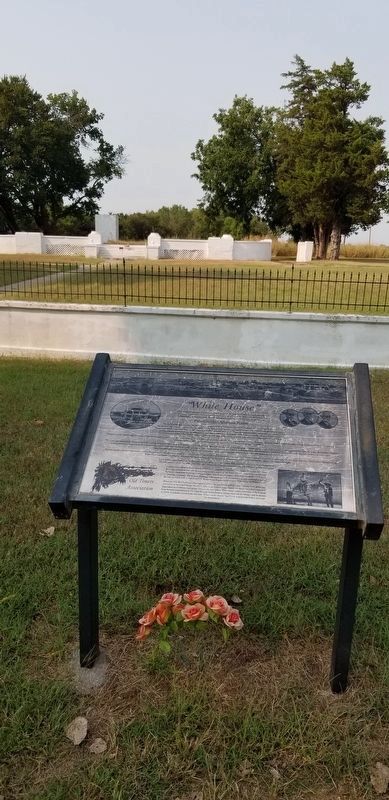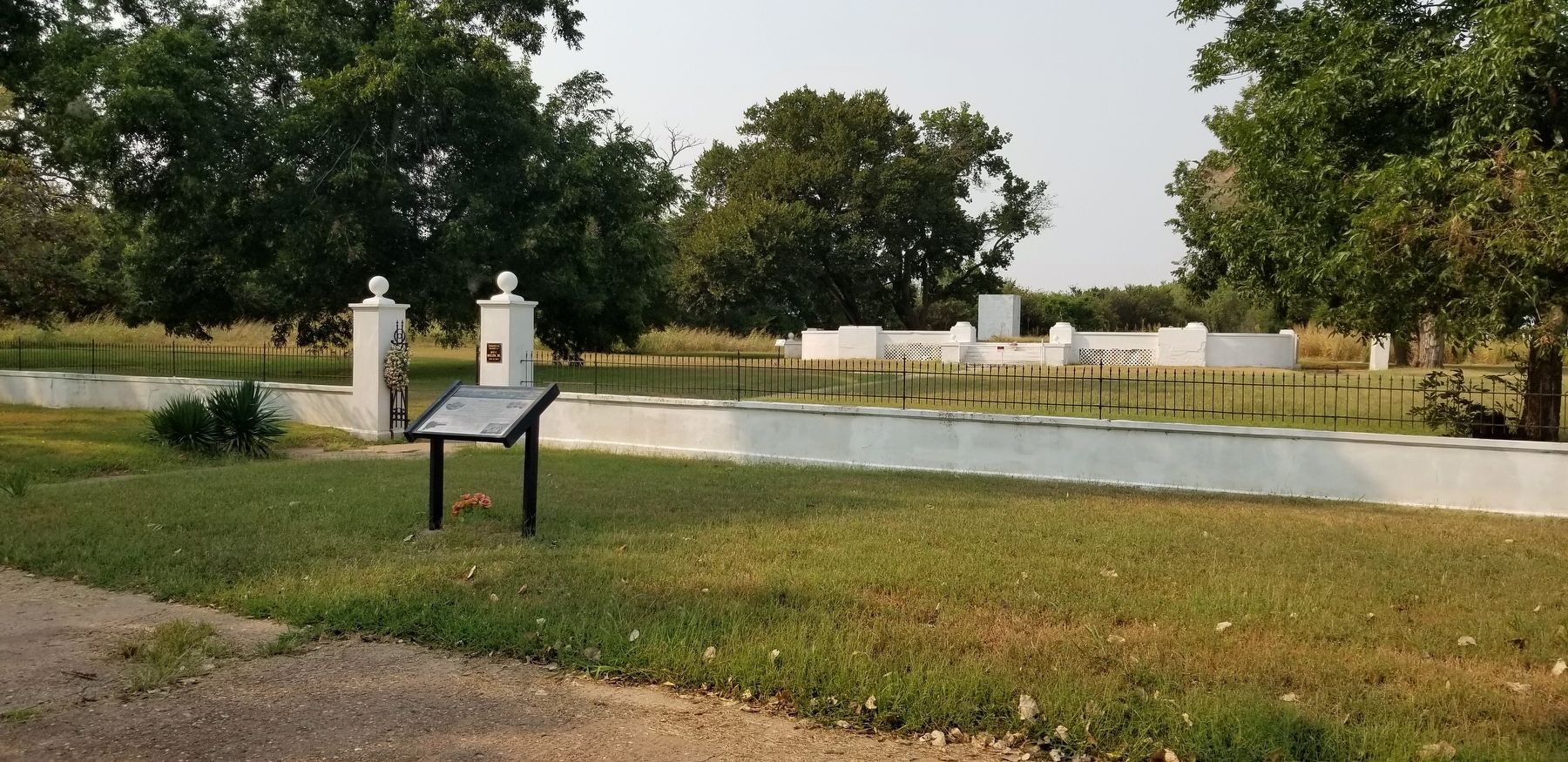Near Ponca City in Kay County, Oklahoma — The American South (West South Central)
"White House"
Palace on the Oklahoma Prairie.
The family home known as the "White House" was the centerpiece of the 101 Ranch Headquarters site. Featuring three stories, the structure had seventeen rooms plus a basement. Nine of these were bedrooms each having its own bath. Other rooms included a spacious living room, dining room, billiard room, bar, and personal office space for the three brothers, library and kitchen. The residence contained every modern convenience available for the time period, some that amazed rural Oklahomans. These included an electric generator plant for electric lights in the house and other buildings around the headquarters site, steam heat, hot and cold water, and hot and cold ventilation.
Designed on the colonial style of a southern plantation, it had two porticoes, one on the east side and one on the west side, both with paved driveways. The front yard of the home featured an ornate wrought-iron fence which was restored in 1999 and again in 2008 by the current property owner. The 101 Ranch Old Timers Association.
The home was constructed of concrete and had an asbestos roof in effort to make it fireproof. The third floor of the White House resembled something like a dormitory and could sleep upwards to 100 visitors in four poster beds with humorous feather tickling mattresses. Visible from the second and third floor of the mansion (... growth of trees and shrubbery) were the orchards, vineyards, vast fields of alfalfa, corn, wheat towards the south (behind you as face this sign) numerous buildings making up headquarters site and "Round Up" performance grounds located about half a mile slightly southeast of here.
Upon the spacious living room (or sitting room) found on the first floor, a visitor would see polished floors covered by colorful Indian rugs white the walls featured western paintings and early day western day artifacts. Each additional room in the White House was finished in different wood while the walls and ceiling were frescoed in muted tones and designs in befitting elegant style of the Old South.
Visitors were common place at the White House and always welcome particular members of the local Ponca Indian Tribe. The tribe named Colonel Joe Miller their Honorary “White Chief” and bestowed their tribal name Muth-a-montha (Going up).
In addition to their solid and friendly relationship with other
area tribes, the Osage, Tonkawa, and Otoe Missouri, prominent national figures were frequent guests at the White House. Artic explorer Admiral Richard E. Byrd, band leader and composer John Philips Sousa, Presidents Theodore Roosevelt and Warren G. Harding, General J. (BlackJack) Pershing, millionaire John D. Rockefeller along artists and actors of the time period as well as important U.S. Senators and Representative were all guests at the White House.
When the 101 Ranch fell into bankruptcy in 1936, the last surviving Miller son, Colonel Zack Miller was evicted from the home. In 1937, federal government purchased the ranch for a subdivision as a depression era resettlement program. This put the once grand White House under ownership of the Federal Farm Security Administration. The Farm Security Administration sold the structure for salvage value at auction in 1943. As a further insult to the one time “Palace on the Prairie” the F.S.A. required the hollow structure be demolished.
Erected by 101 Ranch Old Timers Association.
Topics. This historical marker is listed in these topic lists: Animals • Architecture • Industry & Commerce • Native Americans. A significant historical year for this entry is 1909.
Location. 36° 36.796′ N, 97° 8.357′ W. Marker is near Ponca
City, Oklahoma, in Kay County. Marker is on Ranch Road (State Highway 156) half a mile south of White Eagle Road, on the right when traveling south. The marker is located on the east side of the old 101 Ranch grounds by the highway. Touch for map. Marker is at or near this postal address: 8300 Ranch Road, Ponca City OK 74601, United States of America. Touch for directions.
Other nearby markers. At least 8 other markers are within 6 miles of this marker, measured as the crow flies. Native American Involvement ...in the 101 Ranch (within shouting distance of this marker); 101 Ranch (within shouting distance of this marker); 101 Dairy Barn Vent from Dairy Barn (about 300 feet away, measured in a direct line); Two Old Potato Plows (about 400 feet away); A John Deer Rowe Plow Seed Planter (about 400 feet away); "Indian Trail Marker" (approx. 3 miles away); a different marker also named 101 Ranch (approx. 3.2 miles away); Royal Air Force (RAF) Memorial (approx. 5.6 miles away). Touch for a list and map of all markers in Ponca City.
Also see . . . Miller Brothers 101 Ranch.
In 1881 George Washington Miller first used the 101 brand on his cattle, establishing what would become one of the most recognizable names in ranching and western entertainment. A native of Kentucky, he migrated west after the Civil War, settling in Missouri and driving cattle from Texas to the railway heads in Kansas. Miller later moved his ranch to land leased from the Quapaws, in present northeastern Oklahoma, and resided in Baxter Springs, Kansas. Then he relocated his family to Baxter Springs, Kansas, and his ranch to the Cherokee Outlet. Miller also cultivated a relationship with the Ponca tribe, which was briefly displaced to the Quapaw Reservation. He suggested that the Ponca take land in the Outlet as their home. Source: Oklahoma Historical Society(Submitted on December 14, 2021, by James Hulse of Medina, Texas.)
Credits. This page was last revised on December 14, 2021. It was originally submitted on December 13, 2021, by James Hulse of Medina, Texas. This page has been viewed 257 times since then and 50 times this year. Photos: 1, 2, 3, 4. submitted on December 14, 2021, by James Hulse of Medina, Texas.



